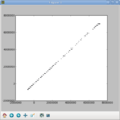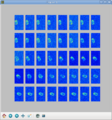2010 Winter Project Week MRI Reconstruction by Registration
Key Investigators
- BWH: Ben Schwartz
- BWH: Sandy Wells
Objective
I am investigating the use of feedback between MRI reconstruction and image registration to deduce both motion parameters and anatomy from a single dataset. My objective for the week is to demonstrate a connected chain from initial reconstruction -> image registration -> new k-space positions -> new reconstruction.
Approach, Plan
Start with initial image sequence (~40 Fiesta images of a moving tomato, tagged with a position parameter). Perform rigid registration between all images in the sequence, using some existing toolbox. Assign registration parameters to the center-of-kspace moment. Fit a curve to translate the position parameter into registration parameters. Evaluate this curve to determine the registration parameters for each line of k-space. Use these deformations to evaluate the true k-space locations, and perform non-uniformly sample reconstruction using some existing toolbox. Repeat as necessary.
Progress
Day 0: I have a dataset, on which initial reconstruction has not yet been performed. This dataset represents images of a tomato moving in a curved path in-plane, taken with Fiesta. Every MRI echo is tagged with a scalar position parameter that is roughly monotone and smooth with position, but not precisely proportional.
Day 1: I performed reconstruction of MRI data according to the position ordering from ultrasound. I learned, from Sandy Wells, the appropriate tools for registering this dataset (ITK, possibly congealing using first-order B-spline as affine).
Day 2-4: Attempt to install ITK. Learn about the structure of the ITK python bindings and WrapITK from Luis Ibañez. Join the ITK mailing list to ask build questions.
Day 5: First working prototype of ultrasound signal database search.

